Stomach, upper hip bones, and more hump.
He still looks like a hybrid giraffe bison, that is only because his muscles and fur come later.
Your Custom Text Here
Stomach, upper hip bones, and more hump.
He still looks like a hybrid giraffe bison, that is only because his muscles and fur come later.
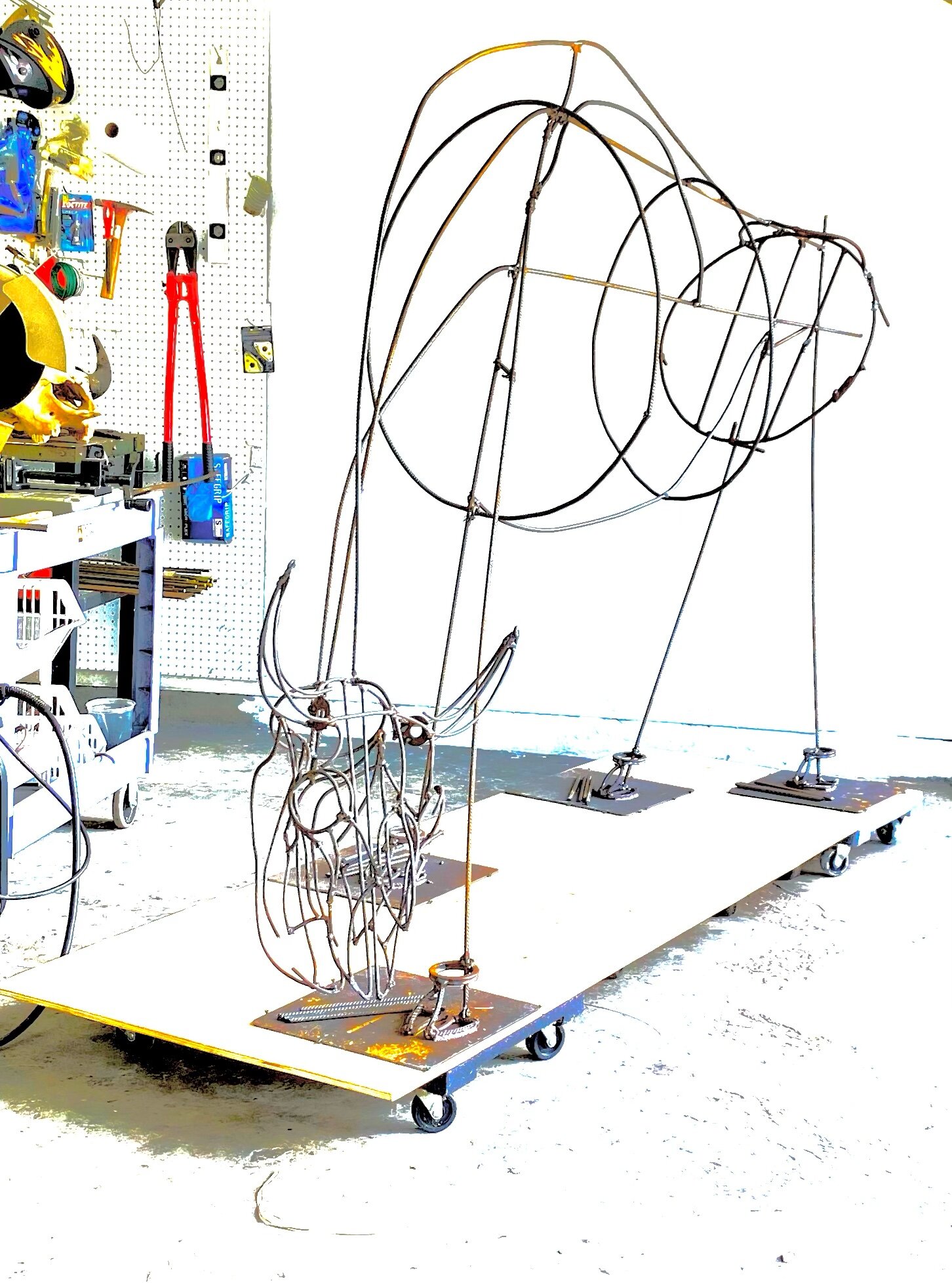
July 5th.
Attaching the head—
I welded just one connection from the neck to the head. As I assemble other parts of his body I will continue to evaluate the position of the head. I want him to be his reaching to the side searching for the next blades of grass within the reach of his massive head and tongue. With only one weld I can easily cut it off if I decide it is not in the right place or at the right angle. I do enjoy having a bobblehead bison in my garage for a while.
Building the girt—
I happened to have a circular scrap piece of rebar almost the right size. I created it years ago to be a round seat for a faux bois chair that was started and not finished. I turned it into the basis for the bison’s rear hip girth/stomach.
It is a little small, the small size gives me the flexibility to add to it exactly where I want it to protrude. As I get more elements worked out I will make it larger by adding the back hip bones that protrude. t is a lot easier to add pieces as I build him than to cut out pieces.

1 small tack world neck to head. Just to see where I want it.
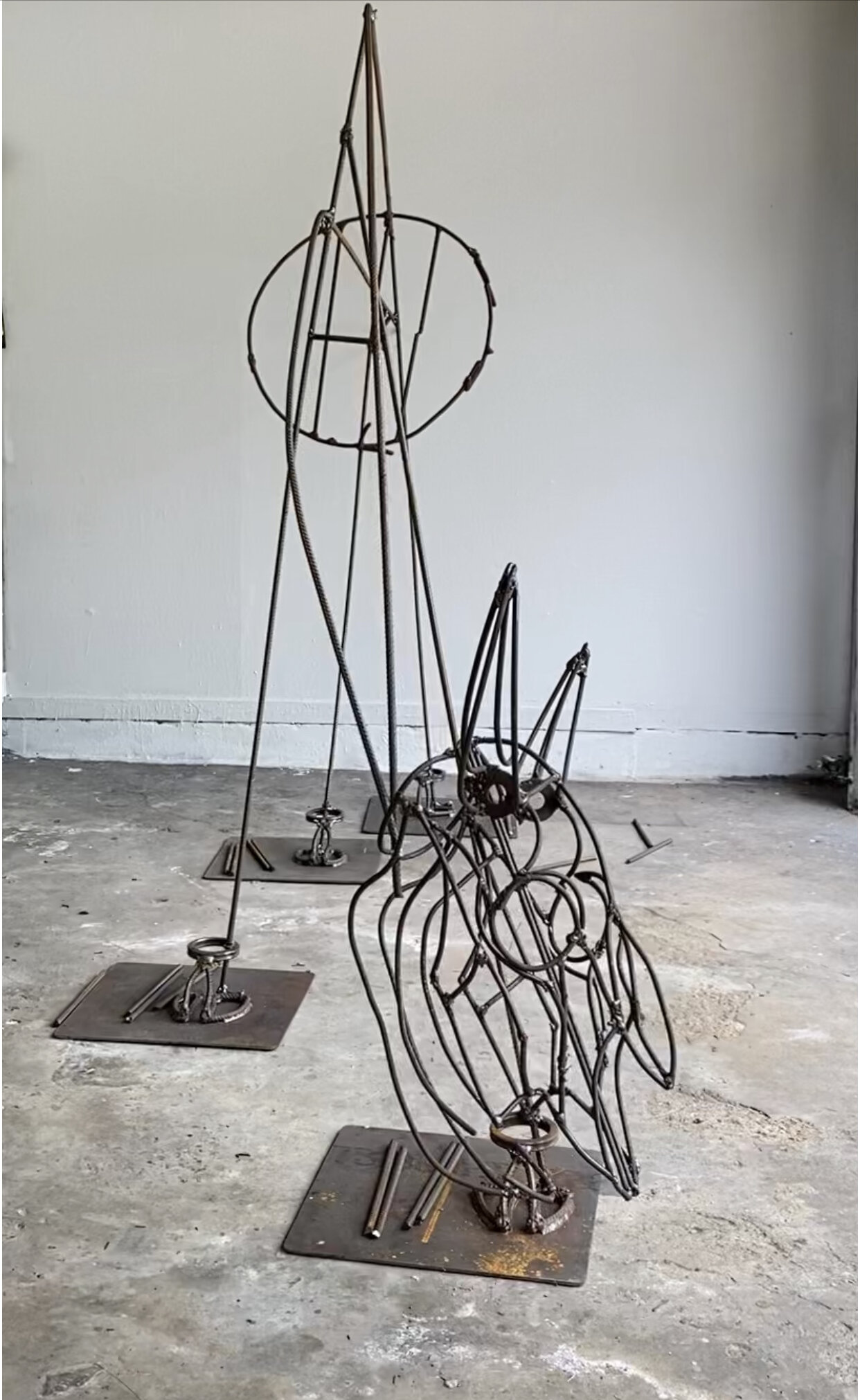

I dried some cosmos leaves to us as the coat of a sculpture that is in the works - Endangered knowledge: the Soul of Humus. The piece will be in the #sculpturemonthhouston 2021 exhibit. I started the armature during COVID for the SMH 2020 exhibit, which was postponed. The sculpture looks at the ecological history of the coastal prairie. This texture is perfect #cindeeklementart #endangeredknowledge #coastalprairie #tezasart #houstonart #bioart #environmentalart #cosmos #art #sculpture #bison
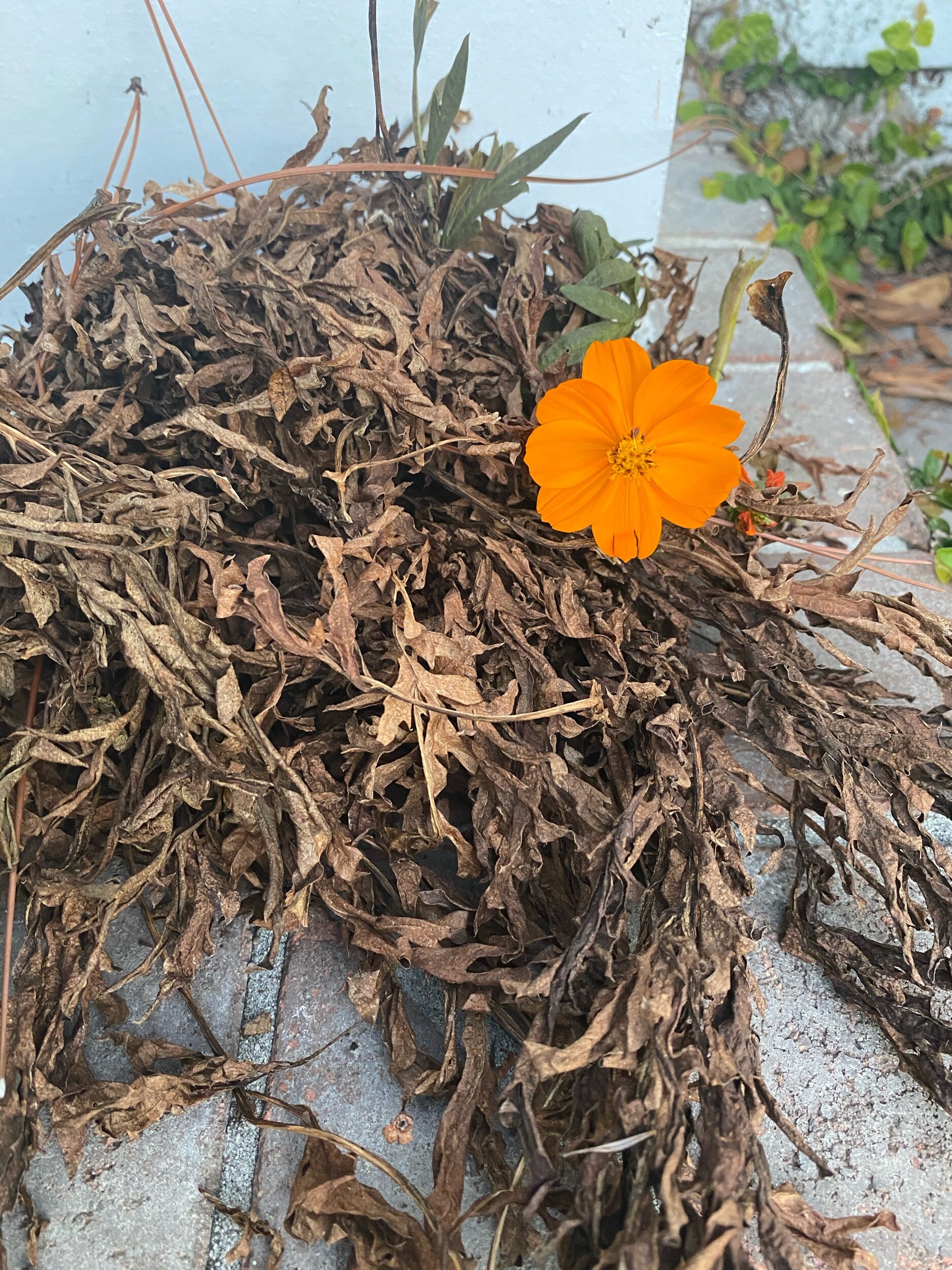

ROOT TO WATER
12” X 18” X 12”
found objects: rusted steel irrigation wheel, root
photo by Nash Bake
Neonicotinoids disturb bumble bee and flies sleep and ability to know when to forage. It is banned in the EU and not in the US. This isn’t enough, these products used in urban gardens harm bees. Articles like these inspire me to plug on.
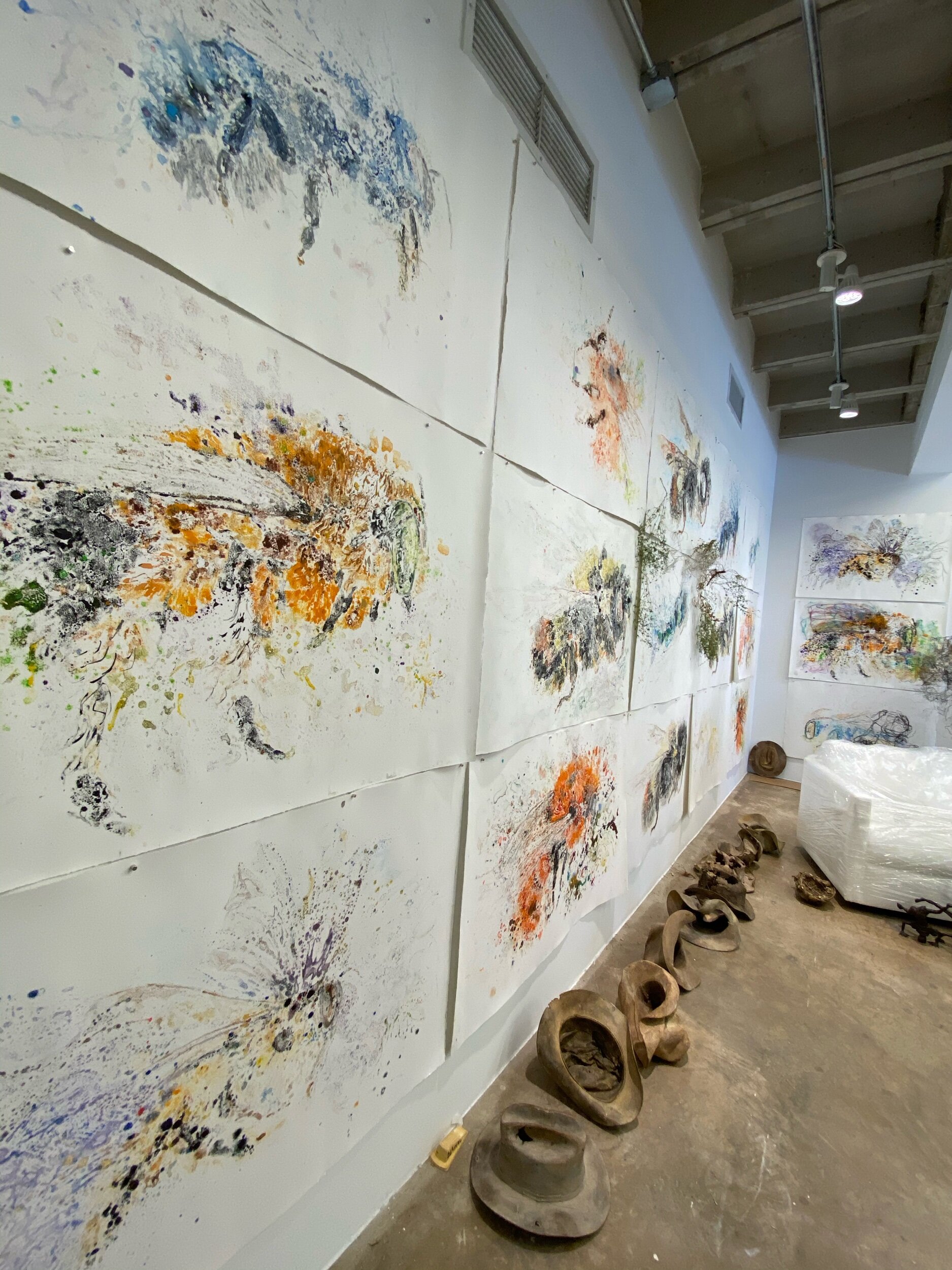
I have lost count
artist statements are also works in progress
as it sits
RUMBLINGS
Artist statement
A rumbling in the distance is nature's way to alert living creatures to their environment.
Rumblings is a work in progress, a monumental collection of fifty 30" X 44" watercolor monotypes that draw attention to the endangered knowledge of the 20,000 species of wild bees.
In these works, I carefully manipulate watercolor ink, and solvent into a chaos of infinitely miniscule paint particles. The materials are interconnected across the over-size monotypes, paralleling the synergistic, aqueous effects of the untold bee species' magnetic attraction to golden dust and their corresponding fragility due to the applied chemicals that flood residential gardens and industrial agriculture. Closely studying their exceptional ability to buzz and pollinate with their exceptional pollen-adhering bodies, I use abstraction and zoom in to depict the organized mayhem of their movements.
The installation of Rumblings inspires curiosity, alerting all viewers to pay attention, asking them to consider the unintended consequences of their actions in our-interconnected micro ecosystems. It is a resounding call to decrease pesticide usage, provide habitats for nesting, and plant native indigenous plants providing nectar for the bees that are responsible for 70% of the foods we eat.
What I do not know is when and where they will be installed, when that is in the picture I may find ways to connect the pieces visually. That will have an impact on the statement. Until the plant beautiful native plants.
After reading the document that listed Bombus Affinis as an endangered species I formed my own opinion by and it does not reflect well on the chemical industry.

Bombus Affinis - the rusty patch bumble bee
In a nutshell, this is what I hope to achieve with my site-specific piece, Symbiosis.

I am rethinking the uses of yard clippings.
In Symbiosis I am stretching my practice and creating a living piece of site-specific art activism that will reimagine a 53.5’ X 48’ traditional urban landscape/sculpture garden and answer the question: how do we holistically restore an ecological balance in Houston? Symbiosis is a collaboration with Lawndale Art Center’s community, neighbors, urban wildlife, and the coastal prairies carbon cycle.
The west border of the garden has five 1 1/2 year old Crepe Myrtle’s a tree famous for murder. The murder refers to badly pruning the tree- down to the knuckles. I was not having these Crape Myrtle’s murdered. Today I used a extractive method of sculpting and clipped- nipped - and cut the existing branches. I shaped the branches/armature of the two end trees.
A sculpture garden has the four seasons of the year and a sculpture garden has the additional change of exhibitions. The pedestals from the last exhibit were still in the garden. 🤔perfect way to highlight the beauty in the wild- the imperfect- the not immaculate urban landscape.
FYI- crepe Myrtle’s are not native however they are a cherished gift to the Art Center. As an optimistic art activist I look at the project holistically to include the desires of the Art Centers board.
When I work in wire, or steele if I cut too much I can always weld it back it add more wire they are forgiving materials. When I clip a branch it is gone- no second chance. .
#artactivism #cindeeklementart #symbiosis #lawndaleartcenter #nativeplants #coastalprairie #sculpture

Create Myrtle cuttings wildly place on a pedestal.
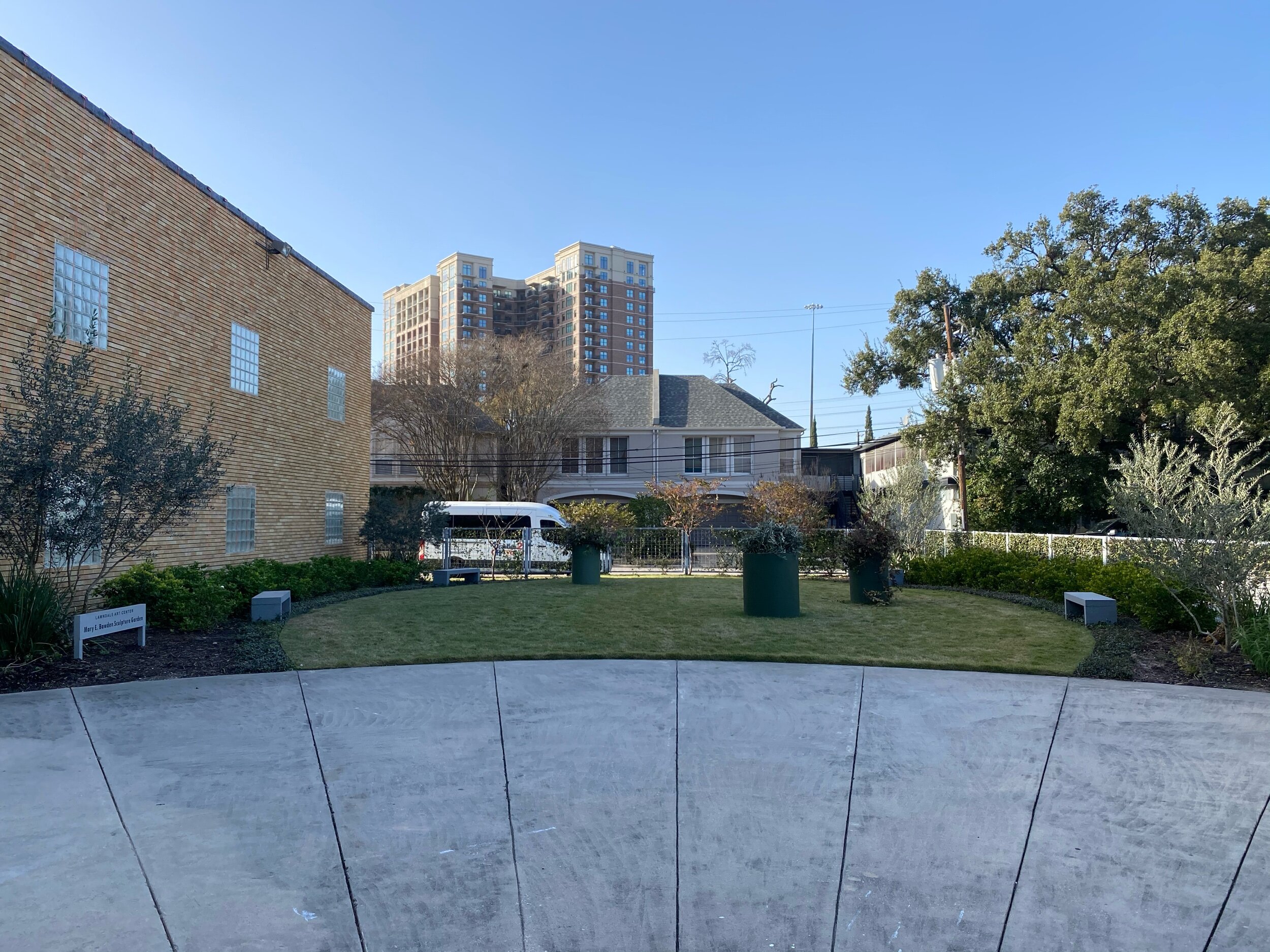

North West Crepe Myrtle after pruning.

Cuttings from two Crepe Myrtle's and the olive trees from a few weeks ago.

South end Crepe Myrtle
Symbiosis is a long term art installation. A piece of dirt in the middle of a large US city, an ecosystem that serves the local art community. Through pairing my intuitive sculptural practice, and natural history research I am sculpting the garden into an ecosystem that balances the needs of the Homo sapien art community and the urban natural world. I spend much of my time filtering through biologist research, inspirational documentaries and interviews of individuals that are leading the way. New Year’s Day I listened to a remarkable podcast an interview of Nora Bateson who is an award-winning filmmaker, writer and educator, The podcast was taped before the pandemic. She knows what she is talking about. Here are two quotes from the podcast that gave me pause and reminded me how grateful I am for my opportunity to make a difference through Symbiosis at Lawndale
“ In my little fantasy there is a great big pause button, and we can say hold everything, let’s regroup, let's turn this titanic around”
“One way or another the systems that we are within are going to change.”
A very enlightening podcast regarding how change and regeneration happens. It is haunting to consider this came out before the Covid 19 quarantine of 2020. Everything Nora talks about addresses the things I am thinking about. She is most definitely an influencer. I will continue to follow and monitor her work.
You can find the interview at The Regenarration podcast on Soundcloud Solve Everything at once.

Checking on the garden I found a moth that was still alive laying in the Pond. I rescued him and laid him out to dry.
How beautiful droplets of dew or rainwater puddle on the waxy leaf surfaces? They provide the watering holes for nature’s tiniest creatures.🐞🐛🕸️🦎🐌🐸🐜🦋🐝
What do you see when you see a leaf? ☘️🌿🌱🍀
I see a unique natural system. Leaves multi-functioning as micro reservoirs, coats of armor protecting the soil, and micro floodgates slowing rainwater. 💦🌊💧
On the Coastal prairie, leaves function to protect the soil from being compacted by the pelting raindrops. If the heavy raindrops fall is not broken by layers of leaves and organic matter, the tiny cavities in living soil collapse, and rainwater moves horizontally across our landscape instead of into the tiny reservoirs in the soil. We need these small cavities to allow water to penetrate deep into the soil. Leaves also slow rain droplets giving the soil time to transport the rain to its deepest roots. Once the rain is in the ground cooling our planet leaves protect the soil from the heat of the day. This multilayered ground cover gives rain more time to trickle into the aquifer. Purifying our water and cooling our planet. How amazing are leaves? As an artist my how we see urban landscapes
My work records endangered knowledge to the collective memory and reimagines urban landscapes to holistically balance the needs of humanity and wildlife.
In Symbiosis I am stretching my practice and creating a living piece of site-specific art activism that will reimagine a 53.5’ X 48’ traditional urban landscape/sculpture garden and answer the question: how do we holistically restore an ecological balance in Houston? Symbiosis is a collaboration with Lawndale Art Center’s community, neighbors, urban wildlife, and the coastal prairies carbon cycle. #symbiosis #lawndaleartcenter #urbanlandscapes #artadia #coastalprairie #water #leaves #conservation art #bioart #nature #contemporaryart #modernart #artactivism #cindeeklementart #texasart #houstonart

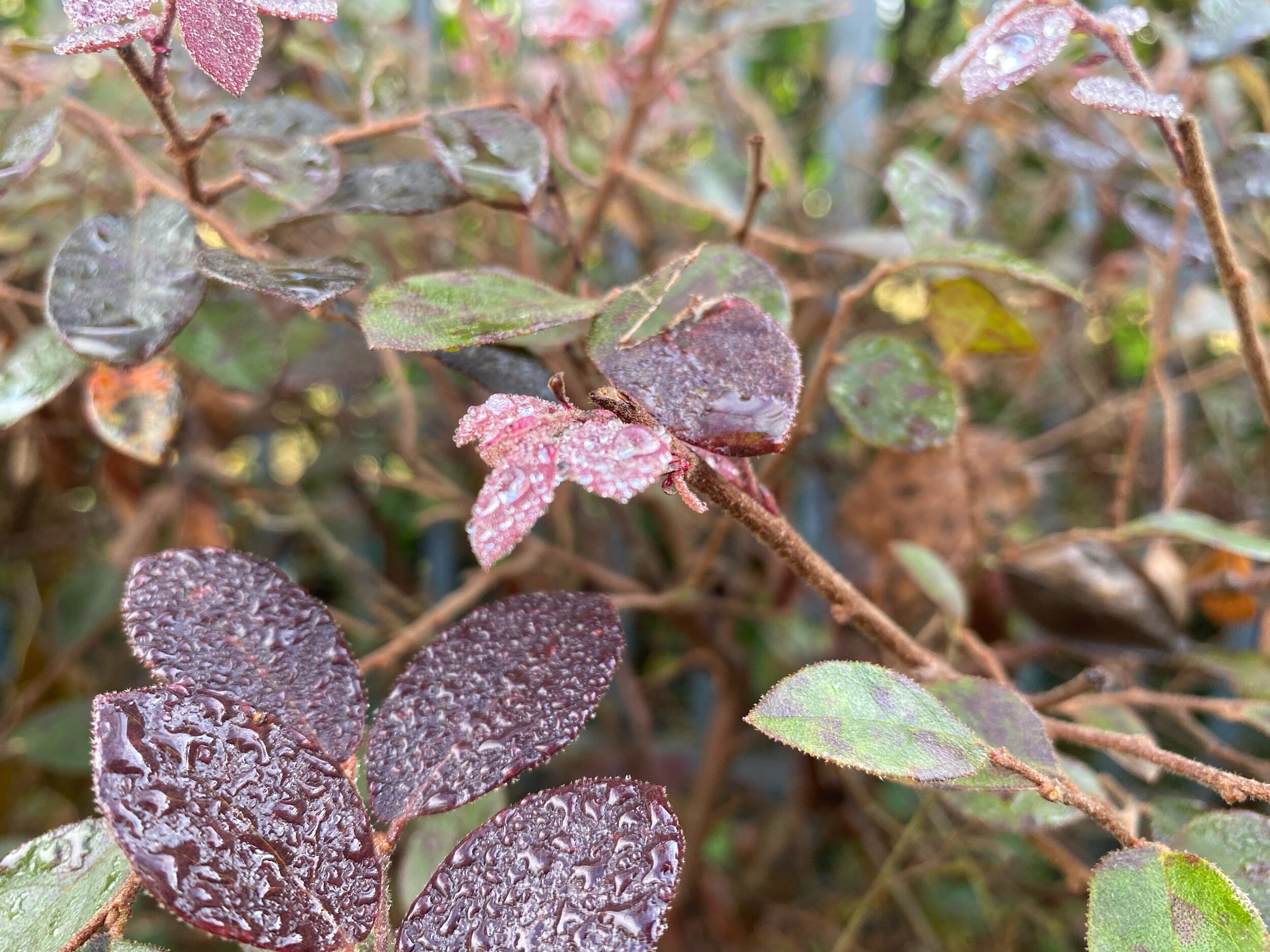
Every morning I start my day reading an email from Sciencedaily.com. I read the environmental and health-related research news, scanning for articles that relate to my environmental/conservation sculptures and monoprints. The article Living environment affects the microbiota and health of both dogs and their owners Is an exciting read for me. My World of Hum kinetic sculpture was inspired by the impact pesticides have on native bee microflora and one aspect of my current work in progress Symbiosis at Lawndale addresses soil microbes in the sculpture garden.

Visitors are relaxing in the garden during a performance piece at the fall opening event.
Dogs are a large part of urban living and, surprisingly, at Lawndale Art Center. Every other day I stop by Lawndale to study the garden, looking for any changes in the soil, leaves, vines, pond water, and look and listen for any wildlife. Often I run into neighbors of Lawndale with small dogs that visit the garden. Stephanie, her four-year-old daughter, and King Charles Spaniel also spend time together enjoying the outdoors in the garden. Sometimes on Sundays, I bring my labrador Tobi with me. It is hard to judge the impact of urban landscapes on those who visit these green spaces with their pets. Living soil unquestionably has an impact on our microbiomes and our pets as well as supports urban wildlife. One of the most interesting books on the subject of our microbiome is I Contain Multitudes by Ed Yong. Dogs

Basically everything we do impacts our microbiomes. In order to build a healthy immune system a key element in any environment is diversity. My sculpture Symbiosis will be have a positive affect on the microbiota and health of both dogs and their owners who spend time in the garden.
When it comes to the environment in the 21st century grasslands beat trees when it comes to carbon sequestration. Our planet is a living breathing organism, impacted by our actions, always changing. I believe It is important that we constantly observe and evaluate how it changes as humans developed and expand across it.
Trees are a thing of beauty but they store carbon above ground in their trunks and limbs.when they catch on fire the trunks and limbs release their carbon into the atmosphere. Grasslands storing carbon underground release little carbon when they catch on fire. In addition the grasslands are a giant sponge soaking up water that prevents dryness and fires.
With the forest fires we have suffered world wide it is time to plant more grasslands and turn these areas suffer ending from droughts into giant sponges for soaking up water and carbon. When the ground is moist then we can can start adding back trees.


Drying coastal prairie native grass in my studio.
”Root To Water” 24” X 12” X 12” irrigation wheel and root found objects.
“How fleeting are the wishes and efforts of man! how short his time! and consequently how poor will his products be, compared with those accumulated by Nature during whole geological periods.”
—Charles Darwin, Origin of the Species
Root to Water offers hope. The root, placed with the root system up, takes on anthropomorphic characteristics, as the wide spread irrigation wheel’s legs are firmly grounded, the humanized root’s bent over posture and downward pointing arm are alive with discovery, the root’s hair like tendrils are actively rewiring its human anthropomorphic brain. This rewiring is happening across the globe, in the most desolate of landscapes citizen conservationists are studying natural law and finding solutions to their man-made problems.
In Root to Water, the irrigation wheel symbolizes mechanistic systems. The root in its natural state represents ecological systems. With this duo, I propose that modern civilization has reached an advanced stage of industrialization. In order to progress to the next stage of civilization we must heed Darwin’s observation, and answer the question how do we pair mechanical innovation with the systems that have functioned through “whole geological periods.” I placed the root above the wheel supporting Darwin’s view of natural systems superiority to human innovation.
Repurposing two tools from agronomy, Root to Water shifts how we see mechanical systems versus naturally occurring systems. In this sculpture, a modern innovation—a rusting, decorative, human-made irrigation wheel—serves as a pedestal for an organic found object that often goes unseen: a root system. With this pairing, I exhibit man’s historical struggle to transition to an agricultural-based society utilizing human-made innovations that extract natural resources instead of harnessing existing ecological systems that regenerate resources.
Communities across the planet are experiencing extreme cases of natural disasters. Houston has experienced three 500-year floods in three years. The U.S. Army Corps of Engineers completed the Buffalo Bayou and Tributaries Resiliency Study, proposing options for controlling flood waters costing up to $12 billion. The report does not include conveyance options that are local nature-based cost effective solutions.
A growing number of conservationists are using natural systems, specifically roots, as a tool for water transportation, carbon sequestration and as a means to cool the planet. Meanwhile, industrial agricultural produces products that are depleting the organic matter, releasing carbon from the soil, and contributing to global warming. As evidence consider, “Each 1 percent increase in soil organic matter helps soil hold 20,000 gallons more water per acre.” In contrast, industrial methods strip the soil (releasing carbon), use petroleum-based inputs to enrich the soil and kill pests. Root to Water elevates roots as a natural system that transports water, minerals and carbon; stabilizes soil; and is instrumental in cooling Earth’s surface—a live-able solution for global warming.
My research-based art looks at the natural history of living soil and how it can be used to restore natural resources that is not commonly understood. I champion natural solutions to environmental issues with a focus on urban landscapes. Root to Water is part of my Endangered Knowledge work, a body of work in progress.
“Though the problems of the world are increasingly complex, the solutions remain embarrassingly simple.”
—Bill Mollison
Further Reading
-Judith D. Schwartz, The Reindeer Chronicles, Water in Plain Site, and Cows Will Save the Planet
-Kiss the Ground, Directed by Joshua and Rebecca Tickell, with WoodyHarrelson
-Organic Matter Can Improve Your Soil's Water Holding Capacity
-The Loess Plateau was the, most highly erodible soil on earth”

How roots talk to each other. My focus is coastal prairie roots, but I expect roots of grass communicate as tree roots communicate. We gave only begun to learn from roots.
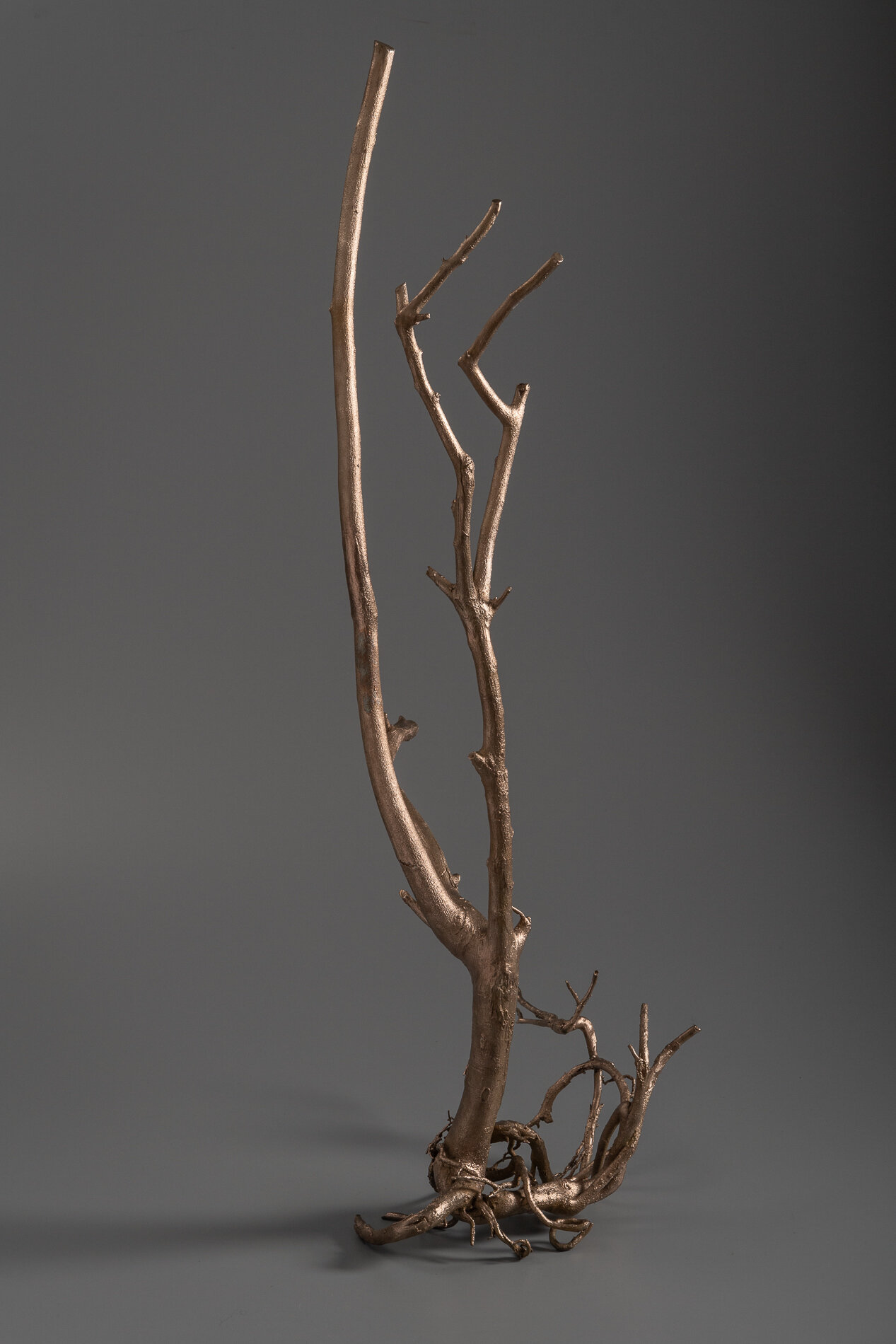
SUBTERRANEOUS SECRETS IV
36” X 8” X 8”
bronze
photo by @nashb Baker
Since the beginning of time, the human spirits' imaginations have been magnetically allured beyond the earth's geomagnetic field, inventing robots, orbiters, landers, and rovers to explore outer space, searching for celestial organisms — fruitlessly.
Secretly between 100 million and 500 billion microbes per teaspoon are living a subterranean life underneath our feet. Living soil is the root of our existence; it is essential to life on Earth. For several years, I have researched grass-fed food production, attended soil conferences, and visited regenerative ranches. (my favorite is @roamranch) Research in these fields reveal how to fight desertification and reverse climate change through regenerative agriculture practices. Interestingly, this natural history of living soil, how it evolved with roots, fungus, plants, food, and animals, carbon and their essential roles within microbial communities in human health, is not common knowledge. Subterraneous Secrets excavates this crucial tool in storing carbon. My work finds new ways to reimagine urban landscapes and records natural history to the collective memory so that it will no longer be endangered knowledge #roamranch #cindeeklementart #bioart #conservationart #environmentalart #root #bronze #bronzesculpture #pesticidefree #texasart #texasartist #houstonart #houstonartist #houstonsculpture #nature #naturalsystems
Termites - to quote @gjklement,” termites are the ultimate grazers” last week, after we harvested our turkeys @roamranch, we went on a hike along the pastures to Indian Cave Creek. Along the way, we saw an abundance of armadillos eating termites. This trip was my 6th trip to the ranch and the first time to see any armadillos on the property, much less numerous armadillos or notice any termites. It is a sign the soil is regenerating - it is a good thing. Armadillos play an essential role in the Texas landscape both in agricultural settings and in urban population centers. They eat Termites keeping them in check. The termites are essential in building functioning ecosystems. As an art activist, I want to change the way we see nature. #regenerativeagriculture #regenerativeart #cindeeklementart #bioart #cobservationart #artactivist #texasartist #houstonartist #womansculptor #art #sculpture
Rural areas are highly impacted by the unanticipated consequences of our industrial agriculture’s dependence on chemicals that weaken bee’s immune systems. Urban bee populations can be more diverse than in rural areas. Researchers are finding in cities such as Chicago, Berlin, Berkley, and Melbourne that have reimagined their parks, neighborhoods, city centers, vacant lots, street medians, and rooftops planted with native flowers, grasses, and fruit, and vegetables support healthy, vibrant wild native bee populations.
In the US, there are four thousand native bee species. They pollinate over three hundred times more effectively than honey bees. For example, A single female Leafcutter Bee visits 100,000 plus blossoms per day whereas a honey bee visits 50-1000.
Houston covers 600 square miles of land and has one of the longest growing seasons in the U.S. As it continues to sprawl across Texas, its gardens must increasingly become a refuge for native plants and animals. With 2.3 million people living in the most vital economic, cultural center of the south, we can become the most critical urban native bee habitat in the United States.
I have spent the last year and a half studying the bee situation as it pertains to my art and my interest in regenerative agriculture. I am determined to take this knowledge and save the bee in urban settings.
With Houston's land size, population, and location in the Sunbelt like it or not-we are impacting the bee population.
ADDITIONAL LINKS
If Cuba can create urban gardens to feed its poor can you imagine what we can do

How do you build soil health without having the luxury of animal impact. It is one thing to build soil health on a bison farm. The microbes in the the the bison, turkey, pig and chicken dung builds the life in the soil. In the sculpture garden at Lawndale I am going to use LEAF MOLD COMPOST. This product is produced primarily from recycled leaves, with a little grass and horse manure mixed in, a touch of fruits and vegetables. After a long slow compost it will be rich in beneficial microbes. It will help save water and promote healthy soil. I was going to wait until early spring before we replanted the garden. However, Sunday Lawndale is having it's Sunday brunch fund raiser. And this is in the day if Covid 19 so the event is outside. I noticed that the heavy rains of late have compacted several areas in the beds and washed away some soil. It will be an opportunity to to talk about living soil,
I spent time researching different types of compost and mulch. Natures Way Resources compost native plants, is locally owned and located in the Houston area. The owner is a soil scientist. I had a long conversation with him today and he really knows living soil. I can't wait to see life return to the garden.
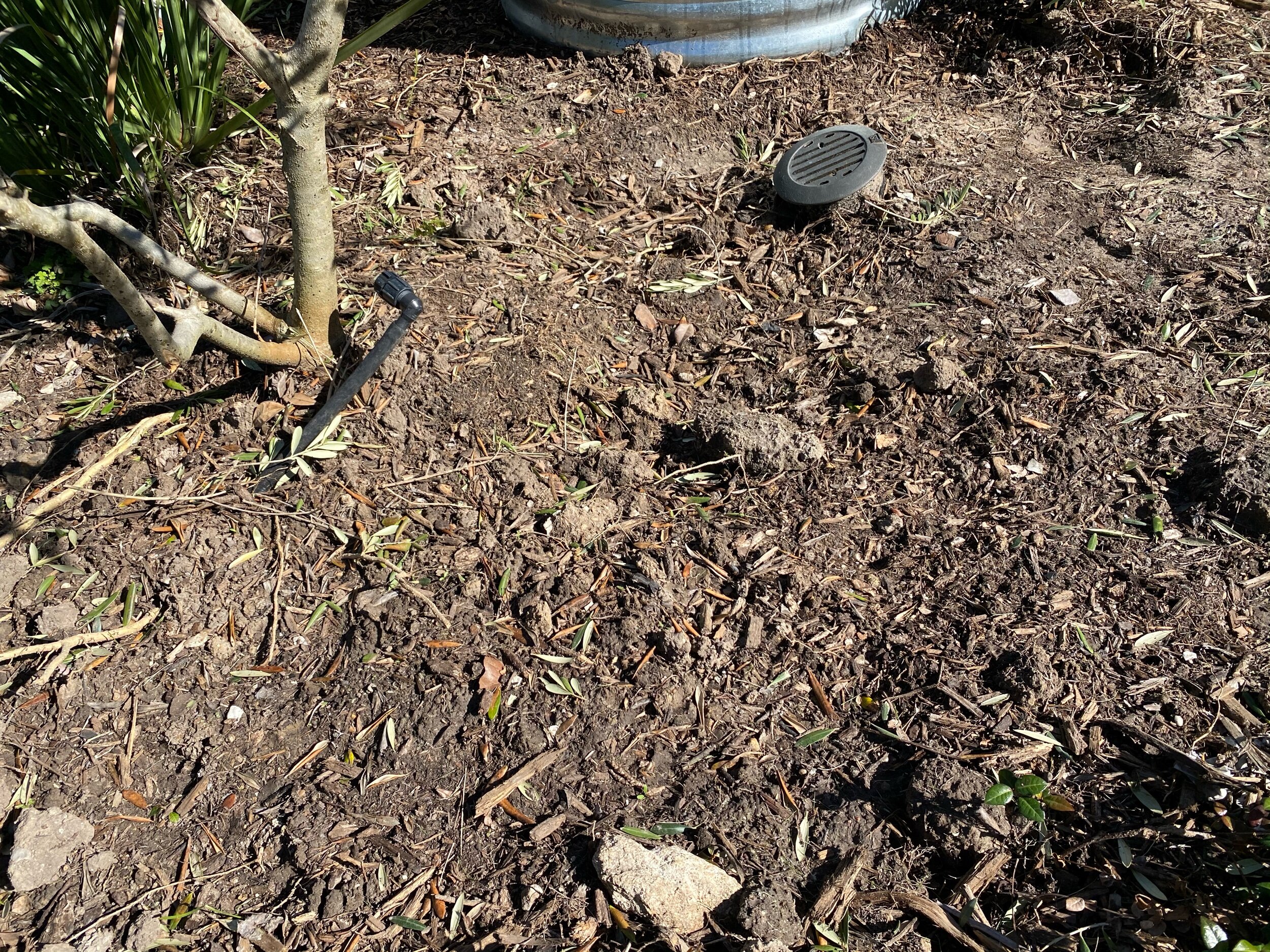
Here you can see how the soil is wearing away without having plants/roots hold it down. You can also see how the rain hitting it had compacted the ground. When the soil becomes compacted it stops absorbing water. .



The goods

The tools


Happy National Soil Day. Notice the length of the root system of this turf grass-just a few inches. 👎
🤔
The image I posted is not soil to be celebrated.It is what I call mindless conformity 🤨AND - now for the good news- 🌱☘️🍀☘️🌿
It is an opportunity to help save our planet and that we should celebrate.
Let me explain- this is the typical ground cover that covers 99.99% of the homes in the United States. It is a mono-crop of turfgrass. Monocrops are not healthy for soil. Mother Nature needs diversity to be healthy. To go against nature, homeowners have to apply chemical inputs to keep their monocrop turf grass looking perfect. These fertilizers, fungicides, herbicides, and pesticides kill all the living matter. They also kill our insects and valuable Keystone species.
In contrast, healthy soil, especially on the coastal prairie, is a sponge for soaking up rainwater and keeping our planet cool. Houston was a coastal prairie covered in native grasses that had massive roots systems. Some extended 18’. The coastal prairie has the capability to absorb massive amounts of moisture/water. They also act as a filter to clean the water and retain water. Water held in healthy soil is how the planet cools itself. Healthy soil also sequesters carbon out of the air and puts it back into the soil. The coastal Prairie plays a large role in the global environment. Houstonians have paved, asphalted, and covered in turf grass 600 square miles that makeup Houston. Reimaging urban landscapes is an opportunity to save our planet. Turfgrass covers more acreage in the US than farmed land. 🤠 this is an easy way to comply with mother nature. I am using ny art to find ways to reimagined urban landscapes to work with mother nature Healthy soil= healthy people. Happy soil day. #cindeeklementart #artactivism #bioart #soilart #art #conservationart #soil #regenerativeart.
The Army Corps of Engineers study to reduce flooding risk does not consider utilizing any nature-based solutions. Here is a fascinating discussion of nature-based solutions that will not cost $1 -$12 billion.
“How fleeting are the wishes and efforts of man! How short his time! and consequently how poor will his products be, compared with those accumulated by Nature during whole geological periods.”
—Charles Darwin, Origin of the Species

I was already working on this piece and the artist/activist/conservationist statement that it visually supports. I am excited to get it photographed and out to the public. There is no question that Charles Darwin had it right. Before we spend $12 billion and wreck the Katy Prairie and Buffalo Bayou let’s review a study by bioengineeers.